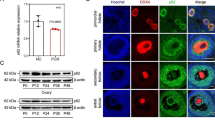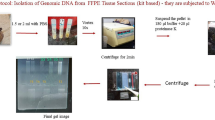Abstract
Objective
A 32-year-old female was diagnosed with unexplained primary infertility for 10 years. She had roughly normal basal hormone levels, but her basal follicle-stimulating hormone (FSH) levels were elevated. In addition, the level of anti-Mullerian hormone was within the normal range, and she had undergone two failed oocyte collection attempts. We aimed to investigate the genetic cause of female infertility in patients with impaired ovarian folliculogenesis.
Methods
Genomic DNA was extracted from the peripheral blood of the patient and her family members. Whole-exome sequencing was performed on the patient, and TBPL2 mutations were identified and confirmed by Sanger sequencing. The Exome Aggregation Consortium (ExAC) Browser and Genome Aggregation Database (gnomAD) Browser Beta were used to search the allele frequencies of the variants in the general population. The harmfulness of the mutations was analyzed by SIFT, Mutation Taster, and CADD software.
Result
One novel mutation, c.802C > T (p. Arg268Ter), and one known variant, c.788 + 3A > G (p. Arg233Ter), in TBPL2 were identified in the infertile family. Compound heterozygous mutations in TBPL2 may be the cause of impaired ovarian folliculogenesis, failure of superovulation, and infertility.
Conclusions
We identified compound heterozygous mutations in TBPL2 that caused impaired ovarian folliculogenesis, failure of superovulation, and infertility in patients. These findings suggest an important role for compound heterozygous mutations in TBPL2 and expand the mutational spectrum of TBPL2, which might provide a new precise diagnostic marker for female infertility.


Similar content being viewed by others
Data availability
The data that support the findings of this study are available from the corresponding author upon reasonable request.
References
Gurunath S, Pandian Z, Anderson RA, Bhattacharya S. Defining infertility–a systematic review of prevalence studies. Hum Reprod Update. 2011;17(5):575–88. https://doi.org/10.1093/humupd/dmr015.
Mascarenhas MN, Flaxman SR, Boerma T, Vanderpoel S, Stevens GA. National, regional, and global trends in infertility prevalence since 1990: a systematic analysis of 277 health surveys. PLoS Med. 2012;9(12):e1001356. https://doi.org/10.1371/journal.pmed.1001356.
Jiao SY, Yang YH, Chen SR. Molecular genetics of infertility: loss-of-function mutations in humans and corresponding knockout/mutated mice. Hum Reprod Update. 2021;27(1):154–89. https://doi.org/10.1093/humupd/dmaa034.
Makker A, Goel MM, Mahdi AA. PI3K/PTEN/Akt and TSC/mTOR signaling pathways, ovarian dysfunction, and infertility: an update. J Mol Endocrinol. 2014;53(3):R103–18. https://doi.org/10.1530/jme-14-0220.
Xiao L, Kim M, DeJong J. Developmental and cell type-specific regulation of core promoter transcription factors in germ cells of frogs and mice. Gene Expr Patterns GEP. 2006;6(4):409–19. https://doi.org/10.1016/j.modgep.2005.09.005.
Gazdag E, Rajkovic A, Torres-Padilla ME, Tora L. Analysis of TATA-binding protein 2 (TBP2) and TBP expression suggests different roles for the two proteins in regulation of gene expression during oogenesis and early mouse development. Reproduction (Cambridge England). 2007;134(1):51–62. https://doi.org/10.1530/rep-06-0337.
Gazdag E, Santenard A, Ziegler-Birling C, Altobelli G, Poch O, Tora L, et al. TBP2 is essential for germ cell development by regulating transcription and chromatin condensation in the oocyte. Genes Dev. 2009;23(18):2210–23. https://doi.org/10.1101/gad.535209.
Wang Y, Xiang M, Yu Z, Hao Y, Xu Q, Kong S, et al. A homozygous missense mutation in TBPL2 is associated with oocyte maturation arrest and degeneration. Clin Genet. 2021;100(3):324–8. https://doi.org/10.1111/cge.13993.
Yang P, Chen T, Wu K, Hou Z, Zou Y, Li M, et al. A homozygous variant in TBPL2 was identified in women with oocyte maturation defects and infertility. Human Reprod (Oxford England). 2021;36(7):2011–9. https://doi.org/10.1093/humrep/deab094.
He WB, Zhang YX, Tan C, Meng LL, Liu G, Li Y, et al. A recurrent mutation in TBPL2 causes diminished ovarian reserve and female infertility. J Genet Genomics Yi chuan xue bao. 2020;47(12):785–8. https://doi.org/10.1016/j.jgg.2020.09.004.
Huang L, Wang F, Kong S, Wang Y, Song G, Lu F, et al. Novel mutations in CDC20 are associated with female infertility due to oocyte maturation abnormality and early embryonic arrest. Reprod Sci (Thousand Oaks Calif). 2021;28(7):1930–8. https://doi.org/10.1007/s43032-021-00524-3.
Jallow Z, Jacobi UG, Weeks DL, Dawid IB, Veenstra GJ. Specialized and redundant roles of TBP and a vertebrate-specific TBP paralog in embryonic gene regulation in Xenopus. Proc Natl Acad Sci U S A. 2004;101(37):13525–30. https://doi.org/10.1073/pnas.0405536101.
Yu C, Cvetesic N, Hisler V, Gupta K, Ye T, Gazdag E, et al. TBPL2/TFIIA complex establishes the maternal transcriptome through oocyte-specific promoter usage. Nat Commun. 2020;11(1):6439. https://doi.org/10.1038/s41467-020-20239-4.
Hamazaki N, Kyogoku H, Araki H, Miura F, Horikawa C, Hamada N, et al. Reconstitution of the oocyte transcriptional network with transcription factors. Nature. 2021;589(7841):264–9. https://doi.org/10.1038/s41586-020-3027-9.
Bártfai R, Balduf C, Hilton T, Rathmann Y, Hadzhiev Y, Tora L, et al. TBP2, a vertebrate-specific member of the TBP family, is required in embryonic development of zebrafish. Curr Biol CB. 2004;14(7):593–8. https://doi.org/10.1016/j.cub.2004.03.034.
Akhtar W, Veenstra GJ. TBP-related factors: a paradigm of diversity in transcription initiation. Cell Biosci. 2011;1(1):23. https://doi.org/10.1186/2045-3701-1-23.
Acknowledgements
We thank the family for participation in the study and the other members of Dr. Yao’s laboratory for their discussion and help.
Funding
This study was supported by grants from the National Nature Science Foundation of China (grant no. 81971373, 82274651, and grant no. 82001618), China Postdoctoral Science Foundation (Certificate Number: 2023M731413), and Jiangsu Funding Program for Excellent Postdoctoral Talent (NO: 2022ZB727).
Author information
Authors and Affiliations
Contributions
B. Y. and J. M. contributed to the conception and design of the study. T. D., M. L., and L. C. analyzed the data and drafted the manuscript. Y. S., Y. W., and H. W. participated in performing the experiments and were involved in data acquisition and analysis.
Corresponding authors
Ethics declarations
Competing interests
The authors declare no competing interests.
Additional information
Publisher's Note
Springer Nature remains neutral with regard to jurisdictional claims in published maps and institutional affiliations.
Supplementary Information
Below is the link to the electronic supplementary material.
Rights and permissions
Springer Nature or its licensor (e.g. a society or other partner) holds exclusive rights to this article under a publishing agreement with the author(s) or other rightsholder(s); author self-archiving of the accepted manuscript version of this article is solely governed by the terms of such publishing agreement and applicable law.
About this article
Cite this article
Du, T., Li, M., Chen, L. et al. Compound heterozygous mutations in TBPL2 were identified in an infertile woman with impaired ovarian folliculogenesis. J Assist Reprod Genet 40, 2945–2950 (2023). https://doi.org/10.1007/s10815-023-02961-2
Received:
Accepted:
Published:
Issue Date:
DOI: https://doi.org/10.1007/s10815-023-02961-2




